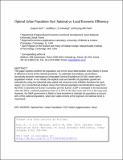Optimal Urban Population Size: National vs Local Economic Efficiency
Author(s)
Nam, Kyung-min; Kim, Euijune; Hewings, Geoffrey
DownloadKim et al_2013_optimal city size.pdf (681.4Kb)
PUBLISHER_POLICY
Publisher Policy
Article is made available in accordance with the publisher's policy and may be subject to US copyright law. Please refer to the publisher's site for terms of use.
Terms of use
Metadata
Show full item recordAbstract
This paper explores whether the population size of the Seoul Metropolitan Area (SMA) in Korea is efficient in terms of the national economy. To undertake this analysis, a recursively dynamic interregional computable general equilibrium (ICGE) model with a population module is developed. In this model, the explicit costs and benefits of population growth are estimated by using the industrial value added and consumer price inflation functions for each region. The counter-factual analysis shows that national population decentralisation away from the SMA is desirable for Korea’s economic growth. Korea’s GDP is estimated to be maximised when the SMA’s national population share is at 39 per cent in the short term and 35 per cent in the long term. However, the SMA government is likely to have incentive to maintain its population at around 40 per cent of the national population, where per capita income at the regional, not national, level is maximised.
Date issued
2013-06Department
Massachusetts Institute of Technology. Joint Program on the Science & Policy of Global Change; MIT Energy InitiativeJournal
Urban Studies
Publisher
Sage Publications
Citation
Kim, E., G. Hewings, and K.-M. Nam. “Optimal Urban Population Size: National Vs Local Economic Efficiency.” Urban Studies 51, no. 2 (February 1, 2014): 428–445.
Version: Author's final manuscript
ISSN
0042-0980
1360-063X